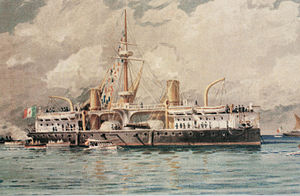Italian ironclad Ruggiero di Lauria

Painting of Ruggiero di Lauria
|
|
| History | |
|---|---|
|
|
|
| Name: | Ruggiero di Lauria |
| Namesake: | Roger of Lauria |
| Builder: | Regio Cantiere di Castellammare di Stabia |
| Laid down: | 3 August 1881 |
| Launched: | 9 August 1884 |
| Completed: | 1 February 1888 |
| Struck: | 11 November 1909 |
| Fate: | Sunk in shallow water 1943 |
| Notes: | Served as floating oil tank GM45, 1909–1943 |
| General characteristics | |
| Class and type: | Ruggiero di Lauria-class ironclad battleship |
| Displacement: |
|
| Length: | 105.9 m (347.4 ft) length overall |
| Beam: | 19.84 m (65.1 ft) |
| Draft: | 8.29 m (27.2 ft) |
| Installed power: | |
| Propulsion: | 2-shafts, 2 compound steam engines |
| Speed: | 17 knots (31 km/h; 20 mph) |
| Endurance: | 2,800 nautical miles (5,186 km) at 10 knots (19 km/h; 12 mph) |
| Complement: | 507–509 |
| Armament: |
|
| Armor: |
|
Ruggiero di Lauria was an ironclad battleship built in the 1880s for the Italian Regia Marina (Royal Navy). She was the lead ship of the Ruggiero di Lauria class, which included two other ships, Francesco Morosini and Andrea Doria. Ruggiero di Lauria, named for the medieval Sicilian admiral Ruggiero di Lauria, was armed with a main battery of four 17-inch (432 mm) guns, was protected with 17.75-inch (451 mm) thick belt armor, and was capable of a top speed of 17 knots (31 km/h; 20 mph).
The ship's construction period was very lengthy, beginning in August 1881 and completing in February 1888. She was quickly rendered obsolescent by the new pre-dreadnought battleships being laid down and, as a result, her career was limited. She spent her career alternating between the Active and Reserve Squadrons, where she took part in training exercises each year with the rest of the fleet. The ship was stricken from the naval register in 1909 and converted into a floating oil tank. She was used in this capacity until 1943, when she was sunk by bombs during World War II. The wreck was eventually raised and scrapped in 1945.
Ruggiero di Lauria was 105.9 meters (347 ft) long overall and had a beam of 19.84 m (65.1 ft) and an average draft of 8.29 m (27.2 ft). She displaced 9,886 metric tons (9,730 long tons; 10,897 short tons) normally and up to 10,997 t (10,823 long tons; 12,122 short tons) at full load. Her propulsion system consisted of a pair of compound steam engines each driving a single screw propeller, with steam supplied by eight coal-fired, cylindrical fire-tube boilers. Her engines produced a top speed of 17 knots (31 km/h; 20 mph) at 10,591 indicated horsepower (7,898 kW). She could steam for 2,800 nautical miles (5,200 km; 3,200 mi) at a speed of 10 knots (19 km/h; 12 mph). She had a crew of 507–509 officers and men.
...
Wikipedia
